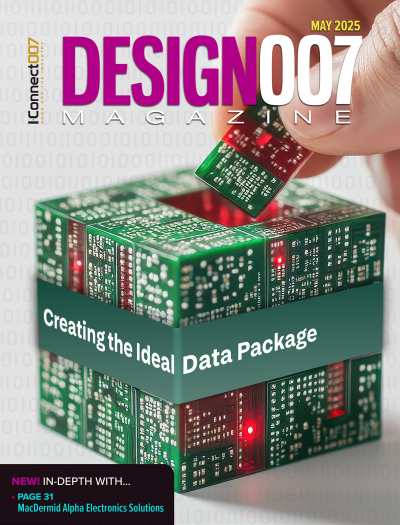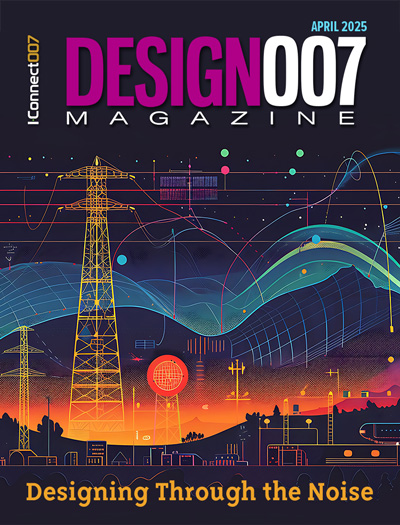-

-
News
News Highlights
- Books
Featured Books
- design007 Magazine
Latest Issues
Current Issue
All About That Route
Most designers favor manual routing, but today's interactive autorouters may be changing designers' minds by allowing users more direct control. In this issue, our expert contributors discuss a variety of manual and autorouting strategies.

Creating the Ideal Data Package
Why is it so difficult to create the ideal data package? Many of these simple errors can be alleviated by paying attention to detail—and knowing what issues to look out for. So, this month, our experts weigh in on the best practices for creating the ideal design data package for your design.

Designing Through the Noise
Our experts discuss the constantly evolving world of RF design, including the many tradeoffs, material considerations, and design tips and techniques that designers and design engineers need to know to succeed in this high-frequency realm.
- Articles
- Columns
Search Console
- Links
- Media kit
||| MENU - design007 Magazine
Happy Anniversary, Gerber Format: Looking Ahead to Digital Innovation
January 25, 2019 | Patrick McGoff, Mentor, a Siemens businessEstimated reading time: 9 minutes
This year, we celebrate the 55th anniversary of the introduction of the Gerber machine language format. We can thank H. Joseph Gerber, the man who took manual PCB design to the next level with the automated photoplotter, for giving us this format in 1964.
At that time, America was still in shock from the assassination of John Kennedy. The Beatles toured the U.S., riding on the popularity of their number one hit single, “I Want to Hold Your Hand.” Gasoline was 21 cents per gallon. “Mary Poppins” (the original) was playing in theaters. Cassius Clay defeated Sonny Liston to become the heavyweight champion of the world. The first Ford Mustang was introduced at a suggested retail price of $2,368. And Gerber Scientific Instrument Company introduced the Gerber format.
A History of Venerable Industrial Achievements
Gerber immigrated to the United States in 1940 with his mother following the death of his father during the Holocaust. Gerber started Gerber Scientific Instrument Company in 1948 to commercialize his first patented invention—the variable scale. He applied his aeronautical engineering degree to developing various solutions for industrial manufacturers.
One of Gerber’s earliest products was a large-area plotter. These were used in the automotive and aerospace industries to plot digitized body components at full scale. To make it easy for the early CAD tools to drive his plotters, Gerber decided to use a numerical control (NC) programming language developed a few years earlier at MIT Servomechanisms Laboratory. Ownership of this NC language was transferred to the Electronics Industry Association (EIA) and became known as EIA-RS274D. This is the same format that the metalworking industry used for two-axis milling.
In 1967, the Radio Corporation of America (RCA) in Camden, New Jersey, asked Gerber to develop an automated Rubylith cutting machine for their nascent PCB application. For those of you not familiar with the design-to-manufacturing process for PCBs at that time, Rubylith was a thick film with a red peelable layer. Design departments used X-ACTO-type knives to cut the PCB pattern at a 20:1 scale. Then, the Rubylith films were mounted on a large-format camera frame for photo-reduction to nominal size. The photo-reduction process reduced the mechanical tolerances of the cutting process.
Gerber asked the engineers at RCA about their end objective and realized that if he imaged directly on the film, the customer could bypass intermediate steps while improving quality. With RCA’s support, the photoplotter was born. There’s a lesson here. Sometimes, it makes more sense to understand and start with the ultimate desired result rather than starting with the focus on just automating a single step in the process—look at the whole forest, not just each tree alone.
Gerber created a derivative of the original format to suit his automated plotters. For example, the “T” codes in Gerber format represented tool (pen, and later, aperture) changes and the “G” codes for linear and circular motion were adopted, but certain miscellaneous (“M”) codes such as M08 for “coolant flood on” were excluded for obvious reasons.
The new photoplotters used a lamp in the photohead to project light through apertures of various sizes mechanically mounted on an aperture wheel to achieve the desired feature sizes on film. Back in the 1960s, 24 apertures pretty much covered all the features sizes and types you needed to design a PCB. Each aperture was sized for the circuit feature sizes of the time—8, 10, 12, 15, and 20 mils round—complemented by special apertures for fiducials and thermal reliefs.
Page 1 of 2
Suggested Items
RTX, the Singapore Economic Development Board Sign MOU Outlining 10-year Growth Roadmap
06/20/2025 | RTXRTX and the Singapore Economic Development Board (EDB) have signed a Memorandum of Understanding (MoU) which outlines a 10-year roadmap to further long-term strategic collaboration in Singapore.
Indra Signs Agreement with AXISCADES to Boost Production of Cutting-Edge Systems in India
06/18/2025 | PRNewswireParis Air Show -- Indra and the Indian technology company AXISCADES have signed an agreement to collaborate on the production of solutions for the aerospace and defense markets.
GKN Aerospace Delivers First High Voltage EWIS System for Clean Aviation’s SWITCH Project
06/16/2025 | GKN AerospaceGKN Aerospace has completed and delivered the first high voltage Electrical Wiring Interconnection System (EWIS) for the Clean Aviation SWITCH project.
RTX's Collins Aerospace Expands Aircraft Electrification Capabilities in Europe
06/12/2025 | RTXCollins Aerospace, an RTX business, expanded its aircraft electrification capabilities with the introduction of a new engineering center of excellence in Wolverhampton, UK, and a new electric thrust reverser actuation systems (elecTRAS) production line in Colomiers, France.
Facing the Future: Investing in R&D to Stay Competitive
06/10/2025 | Prashant Patel -- Column: Facing the FutureIn the PCB industry, staying ahead of the competition requires more than production efficiency; it demands continuous innovation, a firm commitment to research and development (R&D), and a proactive approach to emerging technologies. Companies that invest in R&D are better positioned to develop advanced solutions, enhance product reliability, and adapt to the dynamic demands of the electronics industry.


